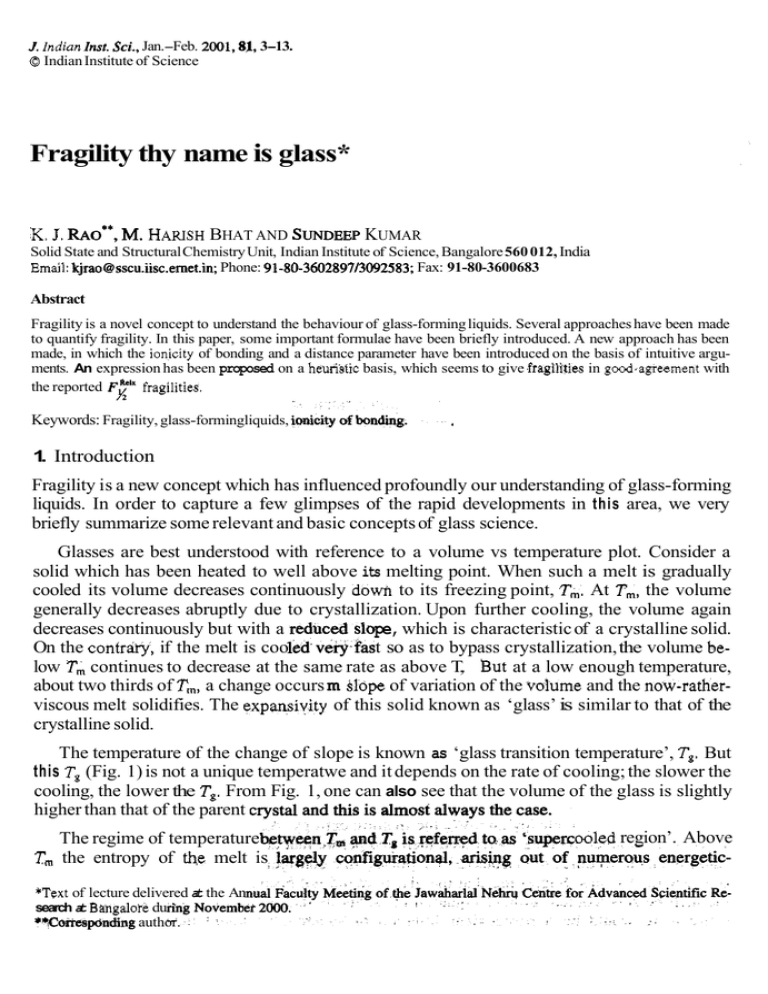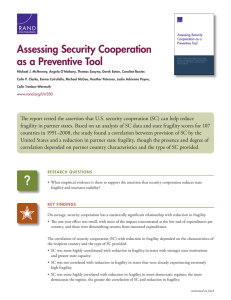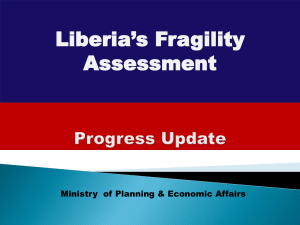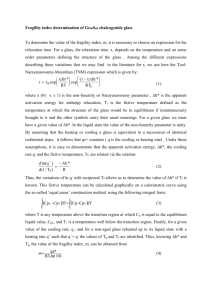is Fragility thy name glass* M.
advertisement

J. Zndian Znst. Sci., Jan.-Feb. 2001,81, 3-13. 0 Indian Institute of Science Fragility thy name is glass* K. J. RAO**,M.HARISHBHAT AND SUNDEEP KUMAR Solid State and Structural Chemistry Unit, Indian Institute of Science, Bangalore 560 012, India Email: kjrao@sscu.iisc.ernet.in;Phone: 91-80-3602897/3092583;Fax: 91-80-3600683 Abstract Fragility is a novel concept to understand the behaviour of glass-forming liquids. Several approaches have been made to quantify fragility. In this paper, some important formulae have been briefly introduced. A new approach has been made, in which the ionicity of bonding and a distance parameter have been introduced on the basis of intuitive arguments. An expression has been proposed on a heuiistic basis, which seems to give fmgilities in good,agreement with fragilities. the reported F? Keywords: Fragility, glass-formingliquids, 1. Introduction Fragility is a new concept which has influenced profoundly our understanding of glass-forming liquids. In order to capture a few glimpses of the rapid developments in this area, we very briefly summarize some relevant and basic concepts of glass science. Glasses are best understood with reference to a volume vs temperature plot. Consider a solid which has been heated to well above its melting point. When such a melt is gradually cooled its volume decreases continuously dowh to its freezing point, T,. At T,, the volume generally decreases abruptly due to crystallization. Upon further cooling, the volume again pe, which is characteristic of a crystalline solid. decreases continuously but with a On the contraiy, if the melt is coo t so as to bypass crystallization, the volume below T, continues to decrease at the same rate as above T,. But at a low enough temperature, about two thirds of T,, a change occurs m &lopeof variation of the volume and the now-ratherviscous melt solidifies. The expansivity of this solid known as ‘glass’ is similar to that of the crystalline solid. The temperature of the change of slope is known as ‘glass transition temperature’, Tg.But this Tg(Fig. 1) is not a unique temperatwe and it depends on the rate of cooling; the slower the cooling, the lower the Tg.From Fig. 1, one can also see that the volume of the glass is slightly higher than that of the parent Tm The regime of temperature the entropy of the melt is *Text of lecture delivered at the An search at Bangaloi-e du **Compdnding author. ooled region’. Above K.J. RAO et aZ. ! I ! FIG. 1. VQlUmeVS temperature plot. FIG. 2. Heat capacity plot. cally equivalent arrangements in which the system can be real configurationalentropy of the molten state is generally lost, but never completely, as the melt is cooled towards Tg. Because of this reason, fewer and fewer configurational states become available to the sup&cooled melt as it nears Tg and even these states are accessed ogly through highly cooperative rearrangements. Therefore, the viscosity increases very rapidly and the system is eventually frozen into a state which corresponds to one of the many local free energy minima. Let us examine the heat capacity plot (C, vs In T, Fig. 2) for the same general case as in Fig. 1. On cooling the melt, its C, decreases very little till when at T, it drops abruptly to the C, value of the crystal. But when so cooled as to bypass crystallization, the supercooled melt continues to follow the same heat capacity behaviour of the melt above T,. The superqooled melt, therefore, always has a higher heat capacity than the crystal. On g further, however, the supercooled melt exhibits an almost abrupt decrease in C, at Tg it solidifies into a glass. The glassy state heat capacity is only slightly higher than $at of the crystal. This drop appears inevitable when we consider the following. Since the heat capacity of the melt is higher in the supercooled region, it loses more entropy than the crystal upon cooling from Tm rd this extra loss of entropy because at T, the melt had acquired ench manifests largely as it is configurationalentropy. But this extra entropy would be lost completely at some temperature, T,, subject to the constraint, T AS,,, = J A C p 1nT (1) TK (AHmis the melting enthalpy and AS,,, the melting entropy. AC, = CJmelt) But TKis never attained by the supercooled melt and b cause the. mIt k b m e s so v i s m s (2 1013poises) ordinary time scales. Su the melt be supercooled cause there would be a paradoxical situation of supercooled liquid having.loweI' entropy 5 S ha. 3. Kauzmann Paradox and entropy catastrophe than the parent crystal. This is more clearly represented in Fig. 3, where entropy, S, itself is plotted as a function of temperature, T, for the same sysbm as in Figs 1 and 2. Upon cooling the melt, if crystallization occurs, entropy drops discontinuously at T, to the value characteristic of the crystal, W e n crystallization is bypassed,entropy decreases down to Tg where it is close to, but slightly higher than, the entropy of the crystal, If the cooling rate is slow, the slope changes at temperatures $till closer to the entropy wive of the crystalke solid. -But it never crosses the entropy curve of the crystal itself because that would be a thermodynamic absurdity, whereby a supercooled melt would possess lower entropy than the crystalline solid itself. This is referred to as ‘Kauzmann Paradox’. The limiting temperature, where the entropy of the glass and crystal become equal is called as Kauzmann temperature, TK,which we have used in eqn (1) to represent the lower temperature limit for integration. If glass transition did not occur and the supercoaled liquid continued to lose entropy at the same rate, then at supercooled liquid would become zero, some temperature greater than OK, which is the unaccep ermady ty (q)of the melt for the same temperature history as in Figs 1-3 is shown in Fig. 4. q increases rapidly in the suq gim. It attains values of the order of 10’3 poises at Tg and therefore behaves as a so ty can be plotted as In q vs 1/T also. Such a plot is very interesting for the present purpose. Such plots reveal generally two types of behaviour. One is a simple Arrhenius behaviour, a linear variation of In q as a function of 1/T, described by the relation, Lquids like S+020rGe02 hke E,O,,SO FIG.4. Viscosity behaviour of a glass-formingliquid. OT CKN 6 K.J. RAO er al. RG.5. Relaxation behaviour of glass-forming liquids. The second is the more interesting Vogel-Tammann-Fulcher (VTF) behaviour, a nonlinear variation of In q vs 1/T. This nonlinearity is removed when q is plotted as a function of (l/(TTo))instead of 1/T and the viscosity is described by the relation: Glass-formers like Si02, GeOz exhibit Arrhenius behaviour, while liquids like B203, Se or ionic glass-forming liquids of the type 60 KNQ.40 Ca(N03)2 (CKN) exhibit YTE behaviour. Behaviour of the relaxation times of the glass-forming liquids for the same region of temperature as the above is even more complex and very revealing. A plot of log v vs 1/T is shown in Fig. 5. The relaxation times vary from s (vibrational) to lo2 s (viscous) in the supercooled region. The variation of the relaxation times appears quite nonlinear and several Arrhenius4ike branches appear to split off from the main curve. The principal ones of interest to glass science are described as a,/3 and yrelaxations. 2. Fragility of glass-forming liquids In this background, we may now discuss the concept of fragility. One should be reminded that this fragility is not the familiar mechanical fragility of a glass, a property which describes the catastrophic breakdown of a glass object subjected to a critical mechanical stress. The fragility here is the fragility of molecular architecture in the glass-forming melt. With reference to Fig. 6 we notice that viscosity varies rather sharply in some VTF liquids just close to Tr Thisvariation is characterized by a high activation energy. Viewed from the glass side of the plot, in a very short temperature range above Tg,the melt becomes quite fluidic in such VTF liquids, as if the constituents of the viscbus liquid or the glass that it was at Tghave broken apart. This tendency is inore in those liquids whose log viscosities depart more severely from the Arrhenius line. The evocative phrase ‘fragile’ describes this departure. It is a measure of the steepness in viscosity drop above Tg;greater the steepness, higher the fragility. 0 .O 0.2 0.4 0.6 0.8 1.o Tg / T FIG.6. Plot of log viscosity as a function of scaled temperature (from Angell’). A plot of log viscosity as a function of scaled temperature (TdT) is more useful in visualizing comparative fragilities. Angell’. classified glass-forming liquids as ‘strong’ and ‘fragile’ on the basis of such a plot. Arrhenius liquids are described as strong while those following the VTF equation are fragile. In contrast to strong liquids, viscosities of fragile liquids exhibit a pronounced divergence near Tg.In a very short range of temperature above Tg,q drops by about 6 to 7 orders of magnitude in typically fragile liquids like CKN. Therefore, a glass formed from a fragile liquid becomes quite fluidic and capable of accessin configurational states in just a short range of temperature above Te The concept of fragility has opened a new window which provides insights into the behaviour of glass-forming liquids. In just under a decade much research work has been reported in K.J. RAO cf al. 8 this area. Fragility itself has been qu the welLknown definitians of fragility to d (i) Very early, Angel14 D m VTF equation (eqn 3). D is a measu rhenius liqearity. (ii) Do& and Hodge6related fragility (F)to transition tempp;razUres as Since viscosity in- tern in Ws'region. (iii) Zhu' defined fragility as the steepness index itself, as measured from the viscosity-reduced temperature plots. F =- Ell RTg * (6) In thh defdtion, F represents the most directly evident property of fragile fiquids plications have already been mentioned. (iv) Richert and Ange11' also related fragility to relaxation times in an indirect manner. Accordirigly, a more convenient Fln (not F)fragility is given by time on a logarithmic scale is at Tg(- la2 s). It is evide so defined by Angcll;' as . (8) 9 where TInis now the temperature at which entropy lost by the supercooled melt is ASd2 and AS,, is the melting entropy. Definitions (4)and ( 5 ) are both logical and intuitive. In the first, a large increase of IJ over narrow range of temperature can only mean that the initial half (high temperature side) of the increase of relaxation time has been slow andhas occurred over more than half of the temperature regime. This results in a quicker increase of zin the other half (lower temperature half) of the tempaature regime. The second is a bit more involved since AS is defined in terms of logarithmic difference in temperature but has similar basis. (vi) Xia and Wolynesg arrived at a fragility relation involving the magnitude of the change in heat capacity at TP (9) where ACp is the difference in heat capacities of the liquid and glass at Tg.This complies with the fact that ionic glasses like CKN exhibit large AC, at Tgand are quite fragile. (vii) Rault" has recently discussed a more involved fragility expression: TI is obtained from the relaxation time expression, z= TO exp &] d n from the stretched exponential function (frequency depend- (viii) Moyqihan" related fragility to experimentally observed width of the glass transition as: On the basis of the observation that Ea(Tg)scale with Tgin several glass-forming liquids. This relation was used later by Ito, Moynihan and Angel1 (IMA)," who examined the relation between ATg/Tgand F,:;'". A plot of ATg/Tgvs F,:? obtained by IMA is represented in Fig. 7. In fact, ATg/Tgis well represented by the function (the smooth line in Fig.7). Fr6m eqn (12), F,:;'" can itself be reformulated as: 0.15 1- x 0.15 1-k x (13) K.J. RAO et al. 10 t FIG. 7. IMA'* plot ATdT, vs 6:;'.The smooth line is function in eqn (12). where x = ATJTg. The preceding compilation of fragility definitions is a telling summary of the intensity of the activities in this area. But the most surprising feature is that no effort appears to have been made to relate fragility to the more fundamental quantities, which determine variations in either viscosity OF entropy. In order to make progress in this direction, we take note of the following commonly observed features of fragile and strong liquids well established experimentally. The fragilities of ionic melts such as CKN in general are high while those of highly covalently bonded materials like SiOz are low. This implies that fragility is related to the ionicity of FRAGILITY I1 bonding. Ionicity of bonding is dete y a (Ax)’ term, where Ax = XA - xc is the differznce in electronegativitiesof A and constitute.the anianic (more electronegative) and cationic (less electronegative) elements in the Althaugh in terms of total cohesive energy ionic bonding is superior to covalent bonding, it is a long-range interaction and nondirectional. Therefore, its contrikution to the local ‘grip’ between the c nts is rather low compared to the same in a covalently bonded compound. Since fra quintessentially breaking apart of the molecular architecture into smaller bits-weaker ‘grip’ should make them more fragile. These are the locally weak ionic bonds. Such weak local bonds can be simply Van der Waals’ type like in ortho-terphenyl. When such weak bonds are excited and a loss of ‘grip’ or resistance to shear occurs, their viscosities rapidly plummet above Tg. It is intuitively obvious that it cannot happen easily in covalently bonded materials. Whatever the nature of these weaker links, their numbers should also matter. Their numbers determine the distance, r, between them. This parameter should influence the fragility. We anticipate that this r may correspond to the size of the cooperatively rearranging region (CRR), which is known to consist of only a few molecules near Tg.This aspect of CRR near Tgis evident in the work of various authors l i e Donth’, Moynihan”, Rault”, Hodge6, Johari14,Plazek and Ngai’’ and others in recent literature. Cluster model of glass transition,16 in fact, recognizes the presence of such weak links between small clustered regions, which exist in the glass around Tg.The weak links result from the highly anharmonic potentials in the cluster model. Therefore, we recognize that there are at least two important physical quantities governed by ionic-covalent bonding in glass-forming liquids, which determine their fragilities. One is the ionicity, which is a Ax2 term and the other is the inverse of a characteristic distance, r, which represents the size of the eventually broken down constituents of glass structure above TB. 4‘ On a purely heuristic basis we suggest that ATg/Tg is a function of (Ax)%, and for want of deeper insight simply use a scaling relation, I where (Ax) is the compositional weighted average of electronegativity differences of all chemically meaningful pairs in a given glass-forming composition, c a constant of proportionality and is taken as 0.08 on the basis of IMA &?? value of SOz. We may, therefore, recast the F,:? fragility relation of IMA in terms of x’ = 0 . 0 8 ( A ~ ) ~instead / r of x = ATg/Tgso that We have considered a number of liquids whose FIn values have been reported by IMA and calculated the x’ values. The primary data are presented in Table I. Generally, it is found that r is simply the inter ionic (bond) distance (tfeating the material as ionic) and is only rarely that a multiple of the nearest neighbour distances is required to be used. For example, in SiOz, r = rsi4+(lv)t rO2-,but in B203, r is the distance from the centre of boroxol ring to the nearest 12 K.J. RAO citrt. be roughly the Donth type of CRR radius in CKN glassq FRAGILITY 13 ble I without further justification. Table I suggests an agreement between Fln (IMA) and F,;* (RBK). A comparison is also made of x and x’ in Fig. 8, which also suggests reasonably good correlation. There is at present no a priori theory of fragility. This empirical RBK approach is, therefore, a modest first effort in this direction in search of deeper meaning of fragility. It may be noted that the use of x’ (with the use of inter-ionic distance for T as a first guess) and not x, can be readily calculated. Therefore, RBK approach has a predictive capability because x’ can be calculated without recourse to other measurements. The form of Fln function used by IMA has been retained by us for purposes of comparison only. The stress in this work is to emphasize the need to develop Fln or some other fragility function, which is dependent on quantities other than ATg/Tg. This is because ATg is often dependent on heating and cooling rates employed in the experiments and hence basically unsatisfactory for the present purpose. The present approach stresses the relation of fragility to fundamental quantities like ionicity of bonding. It introduces in an intuitive way a length scale which in some cases is surprisingly similar to the dimensions of CRR. But there is at present significant arbitration in the choice of r. Further work is in progress to evaluate the ideas presented in this paper. References 1. ANGELL, C. A. In Relaxations in complex systems (Ngai, K. and Wright, G; B., eds), National Technical Information Service, U S Department of Commerce, Springfield, VA, 1984, p. 203. 2. ANGELL, C. A. J. Phys. Chem. Solids, 1988,49,863. 3. GREEN, J. L., ITO,K., Xu, K. AND ANGELL, C. A. J. Phys. Chem. B, 1999,103,3991. 4. ANGELL, C. A. Ann. N.Y. Acad. Sci., 1986,484,241. 5. DONTH,E. J. Non-Cryst. Solids, 1982,53,325. 6. HODGE, I. M. J. Non-Cryst. Solids, 1996,202, 164. 7. Znu,D.M. Phys. Rev. B, 1996,54,6287. 8. RICHERT, R.AND ANGELL, C. A. J. Chem Phys. 1998,108,9016. 9. %A, x.AND WOLYNES, P.G. Cond. Matt.19912442. 10. RAULT, J. J. Non-Cryst. Solids, 2000,271,111. 11. MOYNIHAN, C. T. J. Am. Ceram. SOC.,1993,76, 1081. 12. ITO,K., MOYNIHAN, C. T. AND ANGELL, C. A. Nature, 1999,398,492. 13. PAULING,L. Nature ofchemical bond, Cornell University Press, NY, 1960. 14. JOHARI, G . P. J. Chem. Phys., 2000,112,8958. 15. PLAZEK,D. J. AND NGAI, K. L. Macromolecules, 1991,24, 1222. 16. RAO,K. J. Proc. Indian Acad. Sci., 1984.93, 389.






